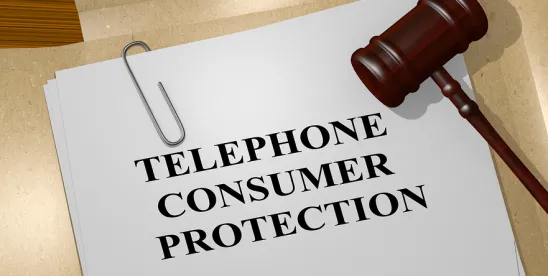Recently a Sixth Circuit panel unanimously agreed in a published opinion that the 2019 Supreme Court decision, PDR Network, LLC v. Carlton & Harris Chiropractic, Inc., does not impact the resolution of a circuit case reviving an unsolicited advertisement claim under the Telephone Consumer Protection Act (“TCPA”).
The Sixth Circuit Case
Matthew N. Fulton, D.D.S., P.C. v. Enclarity, Inc., concerns a 2016 fax received by Fulton, a dental practice, that sought verification or update of the practice’s contact information for use in a medical provider database. Fulton argued that the fax was an unsolicited advertisement under the TCPA and, because it did not contain an opt-out notice, was unlawful. Fulton filed a class-action complaint alleging the fax was a pretext to secure participation in defendants’ database, obtain consent to send additional marketing faxes to recipients, and increase traffic to defendants’ website. Attached to the complaint were FAQs from defendants, which detailed the commercial nature of defendants’ database, and how health care providers’ contact information would be licensed to defendants’ customer base.
Defendants moved to dismiss Fulton’s complaint under Rule 12(b)(6) of the Federal Rules of Civil Procedure, arguing the fax was not an “advertisement” under the TCPA. The district court agreed, finding the fax “lacked the commercial components inherent in ads” because “nothing mentioned in the fax is available to be bought or sold.” Significantly, the district court disregarded Fulton’s attachments to the complaint, believing the Sixth Circuit’s decision in Sandusky Wellness Center., LLC v. Medco Health Solutions, Inc. constrained its analysis to the four corners of the fax.
A split Sixth Circuit panel reversed in 2018. In an opinion joined by Judge White, Judge Stranch first explained that “nowhere does Sandusky confine a court’s consideration of TCPA claims to the face of the challenged fax.” Quite the opposite, actually—“Sandusky repeatedly surveyed ‘the record of evidence’ . . . and, in so doing, went beyond the faces of the two faxes.” Because the fax attached to Fulton’s complaint was part of the record, it could be considered when evaluating the TCPA claim without converting defendants’ motion to dismiss into a motion for summary judgment. The court further held that the TCPA applies to faxes that serve as a “pretext for commercial solicitation,” which includes “future advertising opportunities.” Fulton’s complaint alleged exactly that—providing verified contact information “paves the way for Defendants’ customers to ‘send additional marketing faxes to recipients’”—and was supported by facts contained in the attachment to the complaint. Accordingly, Fulton had stated a plausible TCPA claim “under the fax-as-pretext theory.”
Judge Gibbons dissented. Although agreeing that Sandusky does not limit courts to the four corners of a fax when considering the validity of a TCPA claim, the dissent was troubled by the “highly speculative” nature of Fulton’s claim. In the dissent’s view, neither the complaint nor attachment contained facts suggesting defendants would use, or intend to use, the fax as a stepping stone to future solicitations of Fulton. Absent such facts, the complaint failed to meet the pleading standards of Iqbal and Twombly.
Supreme Court Vacates and Remands
The Supreme Court granted the defendants’ certiorari petition, vacated the decision, and remanded, directing the Sixth Circuit to reconsider the case in light of PDR Network, which also considered whether an unsolicited fax constituted an “unsolicited advertisement” under the TCPA. At issue in PDR Network was whether the Hobbs Act, which vests “exclusive jurisdiction in the courts of appeals to ‘enjoin, set aside, suspend’ or ‘determine the validity of’ FCC ‘final orders,’” obligated district courts to follow a 2006 FCC order determining fax messages promoting free goods or services constitute advertisements under the TCPA. The Supreme Court did not directly answer the question, and instead remanded the case to Fourth Circuit to determine whether the 2006 FCC order was an “interpretive rule” (i.e., one that advises the public of the agency’s construction of the statutes and rules it administers) or “legislative rule” (a rule with the force and effect of law). If interpretive, the rule could not be binding on district courts, and even if legislative, the validity of the 2006 rule could still be challenged by a defendant.
Cool Story, Supreme Court
As directed by the GVR order, the Sixth Circuit panel took a fresh look at Fulton in light of PDR Network. Unlike PDR Network, however, Fulton did not cite or construe the Hobbs Act, defer to the 2006 FCC order, or require the district court to blindly follow the 2006 FCC order irrespective of the TCPA’s text. Rather, both the district court and Sixth Circuit “relied primarily on our precedent and the text of the TCPA to decide whether” Fulton’s complaint stated a claim for relief under the TCPA. Put differently, the 2006 FCC order—regardless of the final outcome in PDR Network—was at most persuasive authority in Fulton, and thus did “not impact the resolution of this case.” More than a year and a half after its first reversal, the Sixth Circuit panel issued a virtually identical decision–both majority and dissenting opinions–as in 2018.



 />i
/>i
